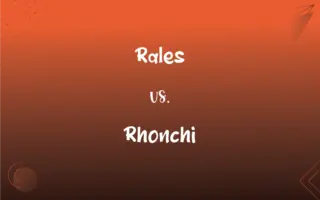Veneer Grafting vs. Side Grafting: What's the Difference?
Edited by Aimie Carlson || By Janet White || Published on February 1, 2024
Veneer grafting involves attaching a scion to a rootstock's side with a thin layer removed, while side grafting involves inserting a scion into a cut on the side of the rootstock.

Key Differences
Veneer grafting is a method where a thin slice of bark is removed from the rootstock and the scion is placed against this cut surface, ensuring cambium layers match. In side grafting, a scion is inserted into a side cut made in the rootstock, aligning their cambium layers.
The technique of veneer grafting requires precise cutting to remove a thin layer of bark without damaging the rootstock, making it suitable for delicate or thin-barked rootstocks. Side grafting, however, involves a deeper cut into the side of the rootstock, allowing for a larger contact area between the scion and rootstock.
Veneer grafting is often used for grafting woody plants and is popular in nursery practices due to its high success rate. Side grafting is more commonly used in fruit tree propagation and is valued for its strength and stability in supporting the scion.
In veneer grafting, the scion is usually secured with grafting tape or a similar material to ensure close contact and healing. With side grafting, the union is often stronger and may require less support, but still benefits from careful binding.
The healing process in veneer grafting involves the scion growing together with the thin sliced area of the rootstock, requiring careful management of environmental conditions. In side grafting, the healing is more robust due to the larger interface, but also demands optimal conditions for successful graft take.
ADVERTISEMENT
Comparison Chart
Grafting Technique
Thin slice of bark removed for scion attachment
Scion inserted into a side cut on the rootstock
Suitable For
Delicate or thin-barked rootstocks
Stronger, thicker-barked rootstocks
Common Uses
Woody plants, nursery practices
Fruit trees, robust grafts
Securing Method
Requires grafting tape or similar material
Often requires less support but benefits from binding
Healing Process
Scion grows with thin sliced area
Scion grows with larger cut surface, robust healing
ADVERTISEMENT
Veneer Grafting and Side Grafting Definitions
Veneer Grafting
A technique used for grafting thin-barked or delicate plants.
For these young trees, the gardener used veneer grafting for better compatibility.
Side Grafting
Side grafting offers a strong and stable union between scion and rootstock.
The pear tree’s successful growth was attributed to the side grafting method used.
Veneer Grafting
A grafting method where minimal damage is done to the rootstock.
Veneer grafting was preferred to preserve the integrity of the fragile rootstocks.
Side Grafting
A grafting technique where the scion is inserted into a cut on the side of the rootstock.
He used side grafting to propagate the apple trees in the orchard.
Veneer Grafting
A grafting method where a scion is attached to a thinly sliced area on the rootstock.
The nursery successfully propagated the delicate saplings using veneer grafting.
Side Grafting
A method suited for fruit tree propagation and larger, thicker-barked rootstocks.
For the new fruit varieties, the farmer implemented side grafting techniques.
Veneer Grafting
Veneer grafting ensures close contact between the scion and the rootstock's cambium.
The rose varieties were propagated using veneer grafting for optimal growth.
Side Grafting
Side grafting involves a larger cut for stronger scion-rootstock contact.
The robust nature of the trees made side grafting the ideal choice.
Veneer Grafting
Veneer grafting involves precise cutting to align the cambium layers of scion and rootstock.
Veneer grafting was chosen for its high success rate with these particular plants.
Side Grafting
Involves a deeper cut on the rootstock, allowing for robust healing and growth.
Side grafting was used to ensure a strong bond between the graft partners.
FAQs
What is veneer grafting?
A grafting method where a scion is attached to a thin slice on the rootstock.
What is the success rate of veneer grafting?
It generally has a high success rate, especially in controlled environments.
Is side grafting stronger than veneer grafting?
Yes, it often provides a more robust union.
How is the scion attached in veneer grafting?
It's placed against the thinly sliced bark of the rootstock.
How long does it take for a veneer graft to heal?
Healing time varies, but it generally takes a few weeks to months.
What is side grafting?
A method where a scion is inserted into a side cut of the rootstock.
Can side grafting be done by beginners?
It requires some skill but can be learned with practice.
What type of plants is side grafting used for?
Mainly for fruit trees and plants with thicker bark.
When is veneer grafting used?
Typically for delicate or thin-barked plants.
Is veneer grafting suitable for all plants?
It's best for woody plants and those with delicate bark.
What's the main advantage of veneer grafting?
It causes minimal damage to the rootstock and is great for delicate plants.
How do you secure a side graft?
Typically, it's bound with grafting tape or similar material.
What tools are needed for veneer grafting?
A sharp knife and grafting tape are essential.
Does side grafting work with all fruit trees?
It's effective for most fruit trees, but specific compatibility varies.
Can side grafting be used in nurseries?
Yes, it's used in nurseries, especially for robust plant varieties.
What are the risks of veneer grafting?
Improper technique can lead to graft failure or damage to the plant.
How does side grafting differ in technique?
It involves a deeper cut on the rootstock for a stronger bond.
Does veneer grafting require special care?
Yes, it requires careful management of environmental conditions.
Is grafting compatibility important in veneer grafting?
Yes, choosing compatible scion and rootstock is crucial.
Can side grafting be used on delicate plants?
It's less suitable for delicate plants due to the deeper cut required.
About Author
Written by
Janet WhiteJanet White has been an esteemed writer and blogger for Difference Wiki. Holding a Master's degree in Science and Medical Journalism from the prestigious Boston University, she has consistently demonstrated her expertise and passion for her field. When she's not immersed in her work, Janet relishes her time exercising, delving into a good book, and cherishing moments with friends and family.
Edited by
Aimie CarlsonAimie Carlson, holding a master's degree in English literature, is a fervent English language enthusiast. She lends her writing talents to Difference Wiki, a prominent website that specializes in comparisons, offering readers insightful analyses that both captivate and inform.






































































